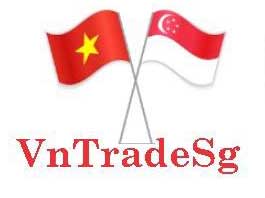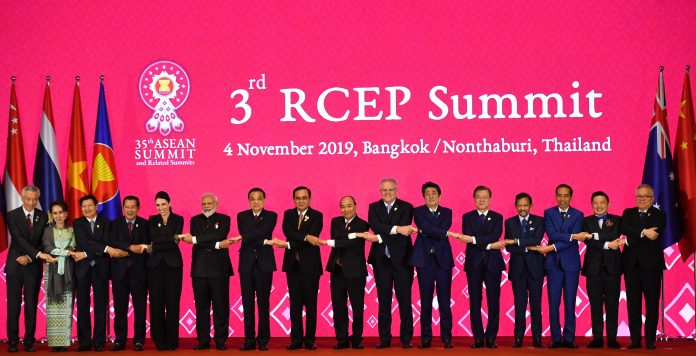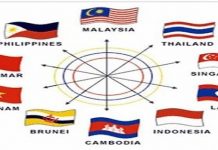Free trade agreement (FTA) generates both winners and losers, and the formation of the Regional Comprehensive Economic Partnership (RCEP) is no exception. This column argues that tariff reduction under RCEP is likely to reduce ASEAN’s exports as it will erode trade preferences of ASEAN granted by existing FTA partners.
RCEP is a regional agreement that aims to liberalize trade and investment, and to strengthen economic cooperation in Asia-Pacific economies. It has gone through several rounds of negotiations since 2012, between 10 member states of ASEAN and six dialogue partners, namely Australia, China, India, Japan, South Korea and New Zealand. In November 2019, the withdrawal of India reduced the number of RCEP negotiating countries from 16 to 15 countries. Nonetheless, RCEP remains the biggest FTA in the world as it has a huge market of US$24.8 trillion and over 2.3 billion people. It is expected to be signed in 2020.
While RCEP presents opportunity to access larger market size, it is likely to generate unfavorable effect for ASEAN’s exports. One of the key trade policy instruments of such a deal is to eliminate tariffs on imports among its members. Usually, tariff eliminations are expected to increase exports. In the context of ASEAN, however, tariff eliminations under RCEP will erode trade preferences in ASEAN as RCEP will overlap with many other ASEAN FTAs.
All ASEAN countries already have FTAs with all of its major trading partners, partly because of its membership in ASEAN Free Trade Area (AFTA), ASEAN+1 FTAs with each of the dialogue partners and Comprehensive and Progressive Agreement for Trans-Pacific Partnership (CPTPP), but also because some of them have bilateral FTAs with each other such as Japan-Singapore FTA, Malaysia-Australia FTA, Japan-Thailand FTA, among others. Therefore, the importance of RCEP as export destinations for ASEAN countries is limited.
The erosion of ASEAN’s trade preferences occurs when ASEAN countries face declines in the competitive advantage that some exporters enjoy in foreign markets as a result of preferential trade treatment provided by FTAs among ASEAN members and between ASEAN as a group and their dialogue partners. But ASEAN exporters will see the benefits of these FTAs reduced by the expansion of preferences to include the additional countries of the RCEP. Higher tariff eliminations under RCEP will result in greater preference erosion and hence reducing exports in ASEAN.
The analysis of top five export destinations for 10 ASEAN countries using export data in 2018 from the International Trade Center reveals that ASEAN countries will have different degrees of export losses from preference erosion. Countries with relatively large export losses include Brunei Darussalam, Indonesia, Lao PDR, Myanmar, Malaysia, Singapore and Thailand, which have some of the top five export markets in ASEAN or dialogue partners. In contrast, Cambodia, the Philippines and Vietnam are likely to face less export losses as they mainly export to the United States, which is not part of RCEP.
We consider two scenarios to demonstrate how preference erosion reduces ASEAN’s exports using ASEAN-China, ASEAN-Japan and ASEAN-Korea FTAs as an example. Before the formation of RCEP, only ASEAN countries have preferential access to the markets in China, Japan and South Korea under the FTAs. Exporters from ASEAN enjoy low preferential tariff rates granted by these three countries, while exporters from the three countries also enjoy low preferential tariff rate granted by ASEAN countries.
Meanwhile, exports from Japan to China or vice versa face the most-favored-nations tariff rates, which are usually higher than the preferential tariff rates. But still, China is the main export market for Japan. After the formation of RCEP, ASEAN’s preferential access to the markets of its dialogue partners will be reduced because RCEP will set the same threshold of tariff reductions on imports among its partners. China, Japan and South Korea will have preferential access to each other market in addition to ASEAN.
This is particularly important for Japan, which has not yet formed any FTA with China and South Korea. In 2018, the top-ranked export destination of Japan was China, followed by the United States and South Korea. The reduction of tariffs under RCEP will generate trade flows among Japan, China and South Korea, and to some extent divert trade flows from ASEAN countries. For ASEAN countries, their preferential access to the markets of RCEP partners will be reduced as part of the market share will be occupied by trade expansion in the dialogue partners.
In conclusion, tariff reduction under RCEP is likely to erode trade preferences in ASEAN as RCEP will emerge in an environment of numerous overlapping FTAs. The erosion of trade preferences means that exporters in ASEAN are likely to face lower demand for their goods in the markets granted by their dialogue partners under ASEAN+1 FTAs. Given the lack of FTA between Japan and its key trading partners, RCEP is likely to intensify trade flows among the dialogue partners rather than stimulating more exports from ASEAN. The key implication of tariff cuts is that export-oriented firms in ASEAN will face tougher competition with foreign firms in the dialogue partners to maintain their market shares.
The unfavorable effect of tariff cuts considered here does not necessarily mean that there is no room for ASEAN to gain from RCEP. If RCEP achieves its objective of going well beyond these tariff reductions, it may be that potential export losses resulted from preferential erosion will be its least important implications. Addressing the issues such as non-tariff barriers, intellectual property rights and e-commerce, among others, will enhance competitiveness and stimulate innovation of ASEAN firms, the benefits of which are likely to greater than potential export losses of tariff cuts.
Source: Business Times Singapore

















